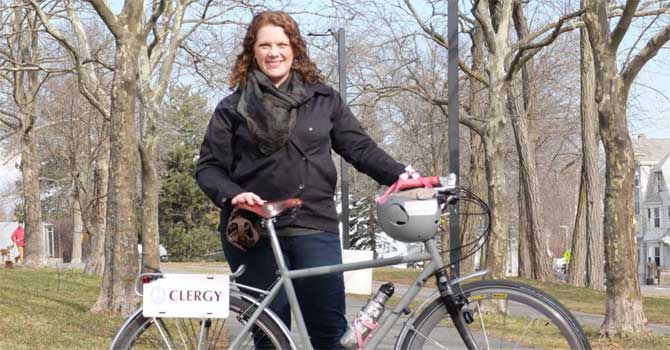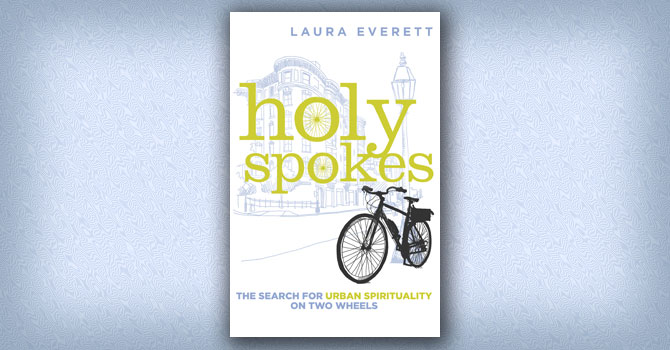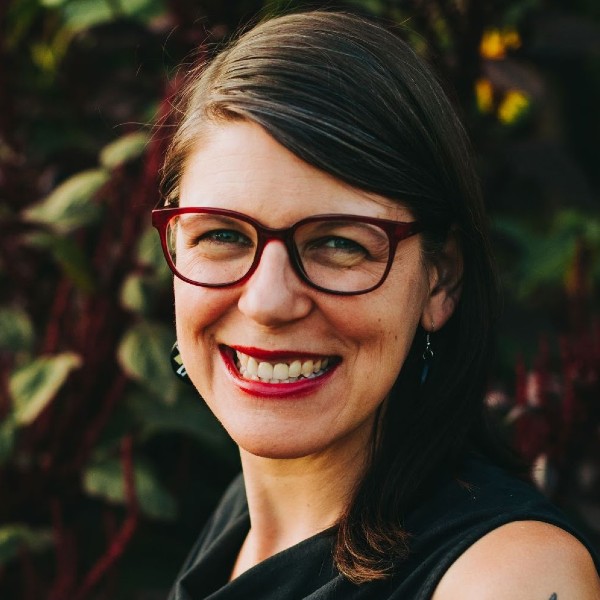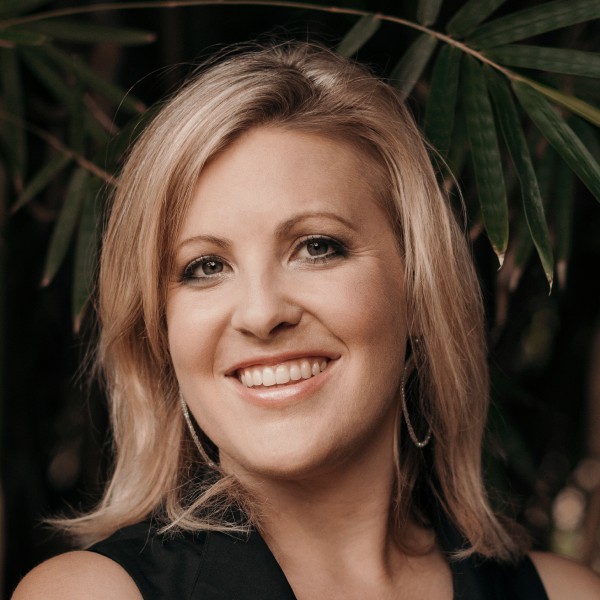When Laura Everett’s car died, she needed an inexpensive way to get around Boston.
That’s when members of her Bible study group persuaded her to try biking. She wasn’t particularly athletic, and she’d ridden a bike only as a kid. But soon she was a regular bicycle commuter.
What she found was that riding a bike was more than just transportation. It transformed her relationship with her adopted home, and it opened her eyes to people and communities she would never have seen through the windshield of a car.
It also became a physical and spiritual discipline.
“We’re not all going to go be holy on a farm in the country or in the mountains,” she said. “For those of us who are committed to cities, or for those of us who can’t leave, we’ve got to be able to find the transcendent in the frenetic, sometimes chaotic motion of cities.”
Her evangelism of bicycling resulted in her new book, “Holy Spokes: The Search for Urban Spirituality on Two Wheels,” in which she writes about bicycling, spirituality and the intersection of the two.
Everett, the executive director of the Massachusetts Council of Churches, spoke to Faith & Leadership about the ways in which bicycling has changed how she lives out her Christian faith. The following is an edited transcript.
Q: What do you mean by “biking as a spiritual discipline”?
I think, broadly, whatever we do daily shapes us, whether it’s getting in a car or riding a bicycle. That movement patterns our lives and shapes who we interact with and how we see our neighbors.
If we take seriously Jesus’ command to love our neighbors, it also requires us to ask ourselves seriously how we see our neighbors, how we interact with our neighbors. Which neighbors do we see, and which neighbors do we ignore?
Q: Is the spiritual component primarily the fact that you, as a bicyclist, are out in your neighborhood more than drivers are?
The spiritual component is twofold. One is the daily discipline of practical cyclists. That’s intentional, and in some ways, it’s countercultural.
The second is about the effect of that intentional moving through the city, which is more vulnerable, more available to one’s neighbor. You are unprotected. You are vulnerable to the weather, to the people around you, in a way that being encased in a giant metal car, separated from the world around, you are not.
There’s an intentionality to practical cycling that I thought was spiritually formative, or I saw becoming spiritually formative for me.
Cyclists have their own habits of packing their clothes, of making sure that they’re wearing something that allows them to move, and of knowing the route to get where they’re going.
This goes to the popular perception of who a cyclist is. There’s a popular perception that a cyclist is someone wealthy, who could take a car but is choosing to take a bike.
But the U.S. Census American Community Survey found that the majority of cyclists are poor, that people use bicycles for transit in great majority because we don’t have viable transit infrastructure.
Q: You write that you became a Bostonian through cycling. In what way do you feel more comfortable claiming that identity as a cyclist?
Boston, like many cities, is transient, and it seemed like there was always the gap between people who had been here for six generations and people who were here for six months.
I remember getting a map of the city embedded in my mind in a way that when driving or taking the bus or subway I never did. I now know how the neighborhoods connect. I now know how Washington Street cuts through Jamaica Plain, and then Roxbury, and then Dudley Square, and then the South End, and then Chinatown, and then downtown, and then Beacon Hill.
By knowing this city intuitively now, I feel deeply connected to it in ways that I didn’t previously.
When I hear of a crash or a shooting in another part of the neighborhood, I know what street that is, because I’ve ridden on it.
I can read the stories in the newspaper about foreclosures and then luxury condos coming in, but I’ve also seen it shift from week to week on my bike commute. In a car, I just zoomed past that.
Q: The chapters of your book begin with quotes from Brother Lawrence. What’s the relationship between a 17th-century monk (who never rode a bike) and a 21st-century cyclist?
I needed a way to make sense of how my daily practice was shaping me. In Brother Lawrence, I found someone who could find the transcendent amid the chaos, and so I thought he could be a conversation partner for me.
While he was at a monastery, he didn’t absent himself from the chaos of the world. He was trying to find what was holy in the midst of clattering pans and noisy brothers and frustrating roommates, and that’s part of what I’m after in this idea of urban spirituality.
We’re not all going to go be holy on a farm in the country or in the mountains. For those of us who are committed to cities, or for those of us who can’t leave, we’ve got to be able to find the transcendent in the frenetic, sometimes chaotic motion of cities.
Q: You have this quote that says, “We must always continue to labor, since in the life of the spirit, not to advance is to fall back.” This is true for a cyclist, literally. What does it mean metaphorically?
This is a part of the life of faith that constantly stretches us in new directions. As we grow in relationship with God, we keep moving forward. More is revealed.
All of this bicycle stuff, none of it was an initiative or a project or a grand design to plant and seed a new ministry. It’s the natural outgrowth of following where the Spirit leads. And so that constant conversation with God moves me forward into some really unlikely places. I find that invigorating.
Q: At another point, you write, “I know for sure I never found this conversation sitting on my couch, reading a book on my own.” Do you think it’s the physical activity, or is it the city?
The part of Christianity that has shaped me the most is exceedingly cerebral. Protestants are really good about thinking our way into a relationship with God.
What the bicycle did was help me move my body in ways that brought me closer to my neighbor and, ultimately, to God. By moving my body on a bike, the chatter of my mind can quiet in a way that allows me to hear God. I need to be tired out to hear that still, small voice.
Q: You mention that spirituality isn’t all beautiful. In the chapter about the bike saddle and endurance, you note that it can be painful.
More often than not, the spiritual life is repetition, and mundane, and kind of a slog. It’s more like riding your bike through the slush of February than it is the delight of June.
Maybe that’s colored by living in Boston, but those mountaintop moments in my life and in Scripture are more the exception than the rule. More often, it’s the day-to-day habituated patterns of moving, eating, working, resting.
I didn’t just want to focus on the glorious, transcendent mountaintop spirituality but the really mundane, practical, Tuesday 5:45 p.m. spirituality.
Q: And that connection with -- there’s a great phrase that you write -- “to get acquainted with the grief of this city.”
Bicycles are remarkable because you can go almost anywhere with them -- on dirt roads, on gravel, on concrete, over grass. But to ride through the city means that you ride in places that are not glorious but sad and tragic, and have been for a long time.
That’s the spiritual life, too.
Part of the spiritual discipline for me is to learn to love it all, not just the landmarks and the showpieces but the precious and beloved lives of each person in every house behind every door.
Q: One place where your life as a pastor and your life as a cyclist have had a very clear connection is in the ghost bike ceremonies. You’ve written a liturgy for these memorial services. What’s the significance of that?
It’s important to say that I didn’t create that ritual. Ghost bikes have been happening since the early 2000s. They started in St. Louis as protest art. It was a way of marking the places where cyclists had been hit and sometimes killed.
My role as a pastor in that has been less to create the liturgy and more to notice the rituals that were emerging from the cycling community. I’m just one part of that.
There are the folks who find the ghost bike, and the people who sand it, and those who paint it, and those who transport it, and those who lock it up, and the people who print the bulletin, and those who work with the police to make sure the roadway is safe.
I’m used to having liturgy in communities where you presume a shared knowledge of a common Scripture and a common hymnody. That’s decidedly not true in the cycling community. Those are people from very, very different backgrounds.
It’s provided some real challenges to know what we can do together, but some things are pretty universal. We name what we long for. We name our grief. We insist that we need one another. Sometimes we sing. Sometimes we light candles.
Every time, people come forward and touch the ghost bike; that’s been pretty universal.
Q: In what ways is the cycling community like church, and what model does it offer to the church?
These are people with a common practice that binds them together, and the belief may or may not be shared; the practice is what is shared. There are some Christian communities like that, but that’s something we could learn.
There are reasons why I want the church to pay attention to this.
One is simply a demographic case. The U.S. Census found that since 2000, bicycle commuting has grown 61 percent in the U.S. That’s massive, and our infrastructure has not caught up with it.
I worry that religious communities are not noticing the new ways that people are moving through the world. It’s worth paying attention to at the very practical level.
Does your church have bike parking outside, or even better, does it have bike parking inside? In what ways are you noticing how people are coming to your community, and how are you encouraging that?
I was hoping in the book that I could encourage traditional religious communities to notice the ways that nontraditional people have their own devotion and way of life.
These cyclists that I’m connected to build community and support one another and practice a way of living that’s deliberate and intentional, with a kind of faithfulness that any good pastor would give her right arm for. But it’s like we don’t know how to recognize it as devout, because it’s not religious in the way that we are.
Instead of cursing the group of cyclists that go out for a Sunday morning mountain bike ride together and call their Sunday morning ride “dirt church,” maybe we could notice what it is that they gain from that. What could we learn from that instead of belittling it?
There’s this great anecdote about Massachusetts during the first big cycling boom in the 1890s and 1900s. When bicycles become commercially available to the masses, the day that people are really able to ride is Sunday, and so the New England Sabbath Protective League gets upset about this.
Incidentally, the New England Sabbath Protective League is a predecessor body of my organization.
Some churches in New England denounce the bicycle. Then a few other churches get wise and set up tent revivals and water stations along the popular cycling routes.
There are some cultural trends that we want religious communities to resist, but there are some trends where we could say, “What is God up to in this, and how could we learn from this and see the goodness already operative?”
Around the ghost bikes, the cycling community reminds me a lot of church in the ways that we honor the dead.
One thing that’s remarkable about the ghost bike ceremony is the number of people attending who do not know the deceased but who come out of a sense of solidarity -- sometimes with a sense that they, too, ride vulnerable and are at the mercy of potentially distracted drivers.
As a Christian pastor, I rarely hold a funeral that has people who show up to it but don’t know the dead. I’m consistently impressed by the devotion that cyclists have for people they don’t know but with whom they share a common practice.
Q: People are connected through vulnerability to that person who died.
Yes, but I don’t want to lose this either: they are also connected by a sense of joy and liberation.
My life is better. My world is bigger. My friends are more diverse. My city is better-known to me on my bicycle.
Part of what a bicycle gives is a sense of urgency and freedom. I can move of my own accord, and I’m not an especially fit person, you know? I can get myself somewhere. I can make a way. I’m not dependent upon a car or upon the timetable of a bus line.
When bicycles first were introduced to commercial markets, some ads called them “freedom machines.” The cyclists I know have the sense of the good life -- that rather than spend an hour with gritted teeth, hands clutched on a steering wheel, I’m getting $10,000 views of beautiful scenery with the wind in my face and power in my legs.














